Density Curriculum
Section 2—Lesson 7: Do Gases Have Density?
Lesson Plan
Materials
- Large plastic garbage bag
- Clear tub filled with water
- Food coloring
- Clear plastic cup (tall and narrow is best)
- Sheet of paper
- Syringe
- 2-3 balloons
- Pin
- Straw
- 2 paper cups
- Pan balance
- Journals
- Does Air Have Mass? sheet (PDF 67 KB)
- Thinking about the Density of a Gas sheet (PDF 71 KB)
Prep Step
- Review the lesson plan, background information, and understanding goals.
- Gather materials.
- Photocopy the sheets: Does Air Have Mass? and Thinking about the Density of a Gas.
Analyze Thinking
Step 1: Do Gases Have Density?
Ask the students, "Do gases have density?"
Collect arguments in support of and against gases having density. Ask students to explain their reasoning and offer any evidence that they can think of for their arguments. They may want to draw some models.
Ask students to again draw models in their journals of solids and liquids, but this time to also draw a model of a gas. Invite a few students to put their models on the board (see Student Models of Solid, Liquid, and Gas).
Two questions or issues should arise from the conversation:
- Does gas (or air) take up space?
- Does gas (or air) have mass?
We really can't take up the issue of whether or not gases have density until we settle these two questions.
Step 2: Analyzing Current Thinking
Pass out the sheet, Does Air Have Mass?. Ask students to answer the following questions on the worksheet.
- Is air matter?
- Does air take up space?
- Does air have mass?
- If you think that air is matter, how could you demonstrate it? If you think that air is not matter, how you could demonstrate it?
- What would you tell someone who disagreed with you about whether air is matter or not? How would you convince them that it is or is not matter?
After students have had a chance to think about the questions, gather some of their ideas. Discuss them, but do not offer a definitive answer. Instead, explain to your students that you are going to offer them some evidence, and see how they think it should be interpreted.
Explore Outcomes
Step 3: Do Gases Take Up Space?

Show the students a large plastic garbage bag inflated with air. Walk around the room and invite them to push on it.
Ask, "Is this convincing evidence that air takes up space? Why or why not?" Collect the students' ideas.
Take a clear plastic cup, turn it upside down, and plunge it vertically into the clear container filled with water. Make sure that the cup is level. The inside of the cup should stay dry. Adding a few drops of food coloring to the water makes the effect even clearer. Another variation is to use a tall thin cup with a crumpled piece of paper taped to the inside bottom (see pictures below). The paper will stay dry. Ask, "Is this convincing evidence that air takes up space? Why or why not?" Collect students' ideas.
 |
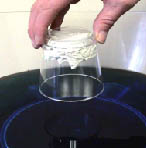 |
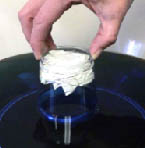 |
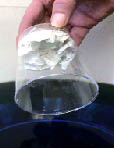 |
Show the students a syringe with the plunger pulled out. Put your finger over the nozzle and invite students to try to push the plunger in. Ask, "Is this convincing evidence that air takes up space? Why or why not?" Collect students' ideas.

Students should notice that in each of these cases, the air is taking up space. The reason you can tell is because the bag, the water, and the finger on the end of the syringe make it impossible (or at least difficult) for the air to move out of the way as it normally does when we move ourselves or other matter into the space that air takes up.
Step 4: Do Gases Have Mass?
Some students do not believe that air has mass. You can demonstrate that it does by placing two uninflated balloons on a pan balance to show that the balloons have equal weight. Next, inflate one of the balloons and place it on the pan balance. The balance should tip down on the side of the inflated balloon, showing its increased mass.
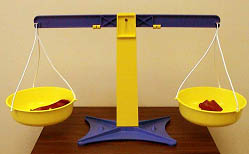 |
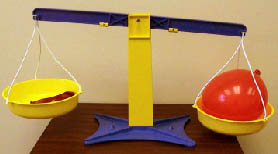 |
Discuss the evidence with the students. Do they consider it to be convincing? Why or why not?
Ask students what they now believe. If gases have density, what would contribute to it? What evidence do they have that gases have density?
Discuss what students find plausible or not plausible about the concept that air is matter. Consider how their reservations make sense and try to put forth relevant evidence to help them see the concept that air is matter as plausible.
Step 5: What Are Possible Ways to Figure out the Density of Gases?
Hand out the sheet entitled, Thinking about the Density of a Gas. Have the students write a paragraph and draw a diagram explaining how they think they could figure out the density of a gas. What would they have to do and why?
In order to define the volume, they should realize that gases take up the shape of the container that they are in. The gas molecules bounce around and bump into the wall of the container. Therefore the container impacts the amount of space that the air can take up—the volume. Eventually, when students study air pressure, you can introduce the concept of "standard pressure conditions."
Step 6: Making Connections
What do the students think about the following question: "When gases are part of an object, so for instance, a plastic ball that is filled with air, the density of the ball is the density of the plastic plus the density of the air inside. Does the air add a lot to the overall density or not?"
Asking this question is a first attempt to get students thinking about mixed density and what it means for something to be hollow as some of their models in Lesson 1 depicted. We will come back to thinking about mixed density in the next section.


